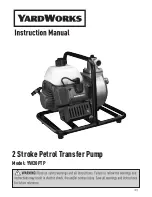
35
SWITCHING OFF FOR LENGTHY PERIODS
PRELIMINARY INSTRUCTIONS
Deactivate the appliance exclusively from the control panel.
I f th e a p p li a nce i s ke p t sw i tch ed of f d u ri ng w i nter, w i th a n
a mb i ent temp era tu re of less th a n 0 ° C a nd yo u d o not w a nt to
u se g lyc ol ( f or exa mp le eth yl ene g lyco l) i n th e h yd ra u li c ci rcu i t,
i t i s recommend ed th a t th e enti re s yst em b e emp ti ed u si ng
th e d i sch a rg e p rovi d ed f or i n th e i nst a lla ti on p h a se a nd th e
a p p li a nce th rou g h th e sp eci f i c d i sch a rg e
OPERATIONS
After deactivating the unit:
- Position the remote switch to the “off” position.
- Turn off the system's main switch.
- Deactivate the interior terminal units by positioning the
switch of each appliance to the “off” position.
- Close the water supply taps.
- Close the hydraulic system shut off valves.
SYSTEM DRAINAGE
- Turn off the system's main switch.
- Check that the system charging valve is closed.
- Open the water discharge valve on the outside of the appli-
ance.
If the system has an anti-freeze liquid, this should not be
simply discharged as it should be treated as special refuse.
ROUTINE MAINTENANCE
PRELIMINARY INSTRUCTIONS
Regular maintenance is essential in order to maintain the
unit efficiency and should be carried out at least once a
year by the Technical Service or by qualified personnel.
Plan the maintenance schedule according to the installa-
tion characteristics and how the unit is used.
For units installed near the sea, the maintenance intervals
should be halved.
After carrying out the necessary maintenance work, the
original conditions should be restored.
Do not open the access covers to perform any mainte-
nance or cleaning operation before having disconnected
the appliance from the mains electricity network, by posi-
tioning the master switch on "off".
CLEANING
Do not open the access covers to perform any mainte-
nance or cleaning operation before having disconnected
the appliance from the mains electricity network, by posi-
tioning the master switch on "off".
Sich das Gerät abschalten und wieder neu einschalten
lässt.
Das Gerät wird ausgeschaltet, wenn alle Versorgungsan-
lage erfüllt sind.
AUSSCHALTEN ÜBER LÄNGERE ZEITRÄUME
WICHTIGE HINWEISE VOR DURCHFÜHRUNG DER AN-
SCHLÜSSE
Das Gerät ausschließlich über die Bedientafel abschalten.
Falls das Gerät im Winter bei Temperaturen unter 0°C
ausgeschaltet bleibt und im Wasserkreis kein Glykol ver-
wendet werden soll (z. B. Ethylenglykol), empfiehlt es sich
die gesamte Anlage über den in der Installationsphase vor-
gesehenen Abfluss und das Gerät über den gerätespezifi-
schen Abfluss zu entleeren.
VORGANGSWEISE
Nach dem Abschalten des Gerätes:
- Den Fernschalter auf “Aus” stellen.
- Den Hauptschalter der Anlage auf “Aus” stellen.
- Die Raumendgeräte abschalten, dazu den Schalter an je-
dem Gerät auf “Aus” stellen.
- Die Wasserzulaufhähne zudrehen.
- Die Absperrventile der Wasseranlage zudrehen.
ENTLEEREN DER ANLAGE
- Den Hauptschalter der Anlage auf “Aus” stellen.
- Sicherstellen, dass der Füllhahn der Anlage zugedreht ist.
- Den Abflusshahn außen am Gerät aufdrehen.
Falls der Anlage Frostschutzmittel beigemengt wurde,
darf dieses nicht unkontrolliert abgeführt werden, da es
sich um Sondermüll handelt.
PLANMÄSSIGE WARTUNG
WICHTIGE HINWEISE VOR DURCHFÜHRUNG DER
ANSCHLÜSSE
Eine regelmäßige Wartung ist von grundlegender Bedeu-
tung für einen störungsfreien Gerätebetrieb und muss
mindestens einmal pro Jahr vom Technischen Kunden-
dienst oder von Fachpersonal durchgeführt werden.
Der Wartungsabstand muss anhand der Installationsei-
genschaften und Verwendung des Gerätes geplant wer-
den.
Bei Geräten, die in Meeresnähe installiert sind, müssen
die Wartungsabstände halbiert werden.
Nach Durchführung der erforderlichen Wartungseingrif-
fe müssen die Ausgangsbedingungen wiederhergestellt
werden.
% Inhibiertes Ethylenglykol
10%
20%
30%
40%
Gefriertemperatur (*)
-4°C
-9°C
-15°C
-23°C
Korrekturfaktor
Leistung
0,996
0,991
0,983
0,974
Leistungsaufnahme
0,990
0,978
0,964
1,008
Druckverluste
1,003
1,010
1,020
1,033
(*) Anmerkung: Die Temperaturangaben sind Richtwerte
Ausschlaggebend sind immer die für das spezifische Modell angegebenen Temperaturwerte
















































